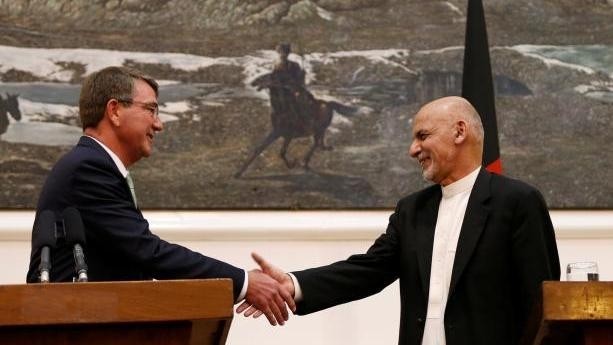US Secretary of Defense Ashton Carter just made an unannounced visit to Afghanistan amid the ‘fiery’ situation in the South Asian country.
Speaking to reporters after talks with President Ashraf Ghani, the head of the Pentagon once again reaffirmed Washington's commitment to supporting Afghan security forces, and appreciated the forces efforts in the fight against the Taliban.
Carter said that the security forces in recent years have shown their determination and resilience in facing the enemy. He expressed his trust that the forces would help bring the stability and security that the Afghan people deserve.
However, the reassuring words cannot drown out the stark reality that Afghanistan still suffers day and night. Violence has continuously escalated since the gradual withdrawal of foreign forces from the country over the past two years, while local security forces are not capable of dealing with offensives from anti-government gunmen.
In addition to the Taliban’s resurgence and unceasing hatred from notorious terrorist group al-Qaeda and its surrounded wings, Afghanistan now also suffers from tramples of the self-proclaimed Islamic State (IS). The number of casualties in the country has also been increasing. Newly-assigned commander of US troops in Afghanistan General John Nicholson said casualties in 2015 doubled figures the US recorded over the 15 years of fighting in the South Asian country.
According to the UN, the rise of the Taliban took the lives of more than 3,500 civilians and wounded over 7,000 in 2015. The Afghan Journalists Safety Committee found that 2016 was the most dangerous year for journalists working in the country. In the first half of the year ten journalists were murdered and 54 cases of violence against journalists were recorded, 38% higher than the same period last year. The Taliban now controls the most Afghan territories since the US launched its invasion in 2001.
In 2015, the Taliban captured the northern provincial capital of Kunduz before the Afghan forces regained this strategic city and sought to stabilise the situation. Not only did they not accept the conditions and sit at the negotiating table with the government, the Taliban also became more brazen in its offensives against the government forces, including public authorities, government officials and military and police forces. Just within the last year, violence claimed the lives of 5,000 troops and wounded 14,000. Helmand, the biggest province among the 34 provinces and cities in the country, has become a ‘fire pan of war’ with constant bloody conflicts. Increased violence has closed the door to the peace talks that have been stalled for more than a year between the Kabul government and Taliban.
While unable to prevent serious security unrest, Afghanistan also continues to witness a political stalemate and profound internal conflicts. A power-sharing government between President Ashraf Ghani and Chief Executive Abdullah Abdullah has not yet healed the deep political and ethnic conflicts that interfere with the country's political life.
The unannounced visit by Carter to Afghanistan took place a few days after US President Barack Obama declared another set of changes to the withdrawal schedule. Accordingly, the US would reduce troops in Afghanistan to about 8,400 by 2017 instead of reducing the number to 5,500 troops as previously planned. The US and its allies in NATO committed to maintain 12,000 troops in the country at least until the end of 2017, mainly focusing on offering training to security forces of the host.
President Obama explained that the withdrawal plan adjustment mentioned above is due to the deteriorating security situation in Afghanistan, requiring careful consideration and cautious decisions. That means, after many efforts in his two terms, the head of the White House cannot realise his commitment to end the wars in Afghanistan and Iraq. The situation in the Afghanistan battlefield shows that the US and its NATO allies cannot yet finish off the long war in the unstable South Asian nation.
















